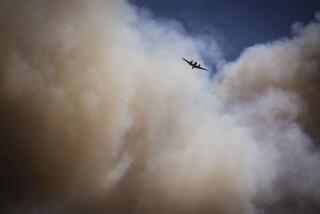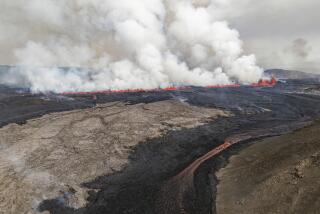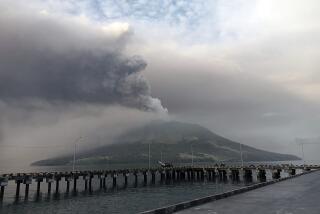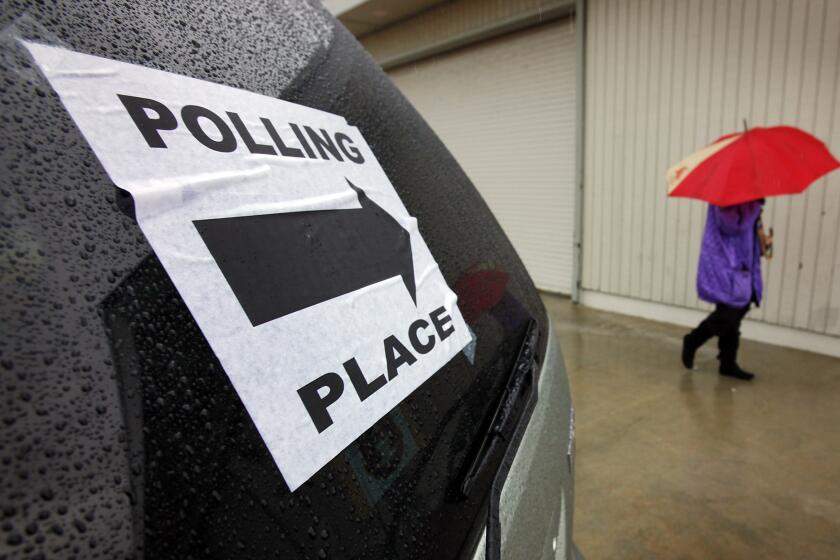Mexican Volcano Erupts, Spewing Lava but Causing No Deaths or Major Damage
MEXICO CITY — One of the world’s biggest volcanoes, Popocatepetl, exploded Monday night in its most powerful eruption in at least 400 years, but the blasts of glowing red rocks did not cause any deaths or major damage around the mountain, which is just 40 miles from Mexico City.
Authorities had urged reluctant villagers living on the volcano’s flanks to evacuate in recent days, fearing that pressure building inside it could cause a dangerous eruption.
Although the volcano hurled bits of debris as far as six miles away, the exhalation consisted mainly of bright ruby streamers of rock and lava that soared up to a quarter of a mile into the air and fell near the crater itself.
Authorities stepped up evacuations from villages perched on the sides and base of the volcano but said they foresaw no major danger to urban areas nearby.
“In this moment, everything is calm,” President Vicente Fox said late Monday after an emergency session with Cabinet members.
Scientists called the volcano’s crimson blasts a historic event.
“We don’t have any records of this level of activity. There are some reports from the 16th or 17th centuries, but not on this scale. It’s possibly more than 500 years” since the volcano was so active, Servando de la Cruz of the Autonomous National University of Mexico’s Geophysics Institute said in an interview with the Televisa network.
Scientists warned, however, that the eruptions could continue in coming days.
The spectacle of the exploding volcano, which burst to life about 7:20 p.m., was so awe-inspiring that motorists stopped to watch as far away as the Mexico City suburbs.
As the eruption occurred, terrified villagers living around the nearly 18,000-foot-high volcano grabbed their belongings and piled into buses provided by the government. The number of residents in shelters shot from 2,400 to 6,850 in a few hours, said Brig. Gen. Javier del Real, deputy chief of the presidential guard, which was involved in the rescue operation.
The last catastrophic eruption from Popocatepetl, known locally as Popo, occurred about AD 800, according to the government’s disaster prevention agency. The volcano became active again in 1994 after lying dormant for nearly seven decades.
A week ago, minor eruptions began shaking the mountain, producing clouds of ash that reached Mexico City, 40 miles to the northwest.
By Monday, the volcano appeared to have quieted. But experts said the apparent calm was a more dangerous sign than the rumbling and belching of previous days.
The silence, the experts said, was a sign that the volcano was blocked by a plug of lava impeding the escape of gases. The building pressure, they said, could result in a dangerous eruption.
The volcano “is like a pressure cooker without the hole for the steam,” Interior Minister Santiago Creel said at a news conference Monday morning.
In recent days, authorities had appealed to 40,000 people within a seven-mile radius of the volcano to evacuate. But many declined, either out of fear of looting or because the volcano seemed no more rambunctious than usual.
That attitude changed rapidly Monday night.
A loud rumbling shook the volcano shortly after 7 p.m., witnesses said. Then, the glowing stream of rocks and chunks of lava began shooting into the air.
Swiftly, churches in villages along the volcano began ringing their bells, summoning local people to flee. More than 2,000 soldiers helped residents in 20 towns board buses to get away from the behemoth the Aztecs dubbed the Smoking Mountain.
“Until now, people said they weren’t afraid. But today they felt fear,” Javier Inclan, who was evacuated from the town of Amecameca, said in an interview with Televisa. “People were paralyzed, and it caused chaos in some families. In the last six years of [volcanic] activity, today was the strongest I’ve ever seen.”
For all the fear, though, the evacuation appeared to go smoothly.
Earlier Monday, federal officials declared a “state of preventive emergency” in parts of three states around the volcano, allowing them to dip into special government funds to set up shelters and provide aid.
De la Cruz, the volcano expert, said it was fortunate that the eruption was long and sustained rather than brief and more explosive. That allowed pressure to escape without catastrophic damage, he said.
Oscar Navarro, the federal government’s director of civil protection, said the size of the lava plug had mushroomed to 490 million cubic feet in just 19 hours.
By comparison, he said, the last time the volcano had a notable eruption, in 1997, the plug was only 210 million cubic feet and had formed over a year.
More to Read
Sign up for Essential California
The most important California stories and recommendations in your inbox every morning.
You may occasionally receive promotional content from the Los Angeles Times.










